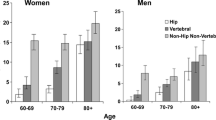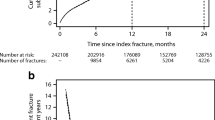Abstract
Osteoporosis is a leading health problem worldwide due to the morbidity and mortality associated with fractures. However, a large number of fractures occur in persons without osteoporosis, when defined by bone mineral density alone. Numerous studies have shown that the risk of subsequent fracture is increased following fractures at most sites, and the increased risk is not limited to prior hip and vertebral fractures only. In addition, the amount of trauma present at the time of a fracture event appears to have limited impact on future fracture risk. Thus, even fractures that occur in the presence of high trauma should be recognized as evidence of possible bone fragility. Further methods to better identify persons at risk of future fracture are needed, such as through evaluation of other indicators of bone strength or recognition of modifiable, non-bone factors. Any initial fracture event is important for patients and caregivers to recognize as an implication for future fracture risk.

Similar content being viewed by others
References
Papers of particular interest, published recently, have been highlighted as: • Of importance •• Of major importance
Cummings SR, et al. BMD and risk of hip and nonvertebral fractures in older men: a prospective study and comparison with older women. J Bone Miner Res. 2006;21(10):1550–6.
Wainwright SA, et al. Hip fracture in women without osteoporosis. J Clin Endocrinol Metab. 2005;90(5):2787–93.
Clinician’s Guide to Prevention and Treatment of Osteoporosis. 2009; Available from: http://www.nof.org/sites/default/files/pdfs/NOF_ClinicianGuide2009_v7.pdf.
Center JR, et al. Risk of subsequent fracture after low-trauma fracture in men and women. JAMA. 2007;297(4):387–94.
Kanis JA, et al. A meta-analysis of previous fracture and subsequent fracture risk. Bone. 2004;35(2):375–82.
Klotzbuecher CM, et al. Patients with prior fractures have an increased risk of future fractures: a summary of the literature and statistical synthesis. J Bone Miner Res. 2000;15(4):721–39.
•• Warriner AH, Patkar NM, Curtis JR, et al. Which fractures are most attributable to osteoporosis? J Clin Epidemiol. 2011;64(1):46–53. The results of an expert panel process evaluating osteoporosis-related fractures are presented. The panel concluded that most fractures are associated with osteoporosis in men and women over the age of 65 years. The predicted likelihood of all fractures being due to osteoporosis are reported.
•• Taylor AJ, et al. Clinical and demographic factors associated with fractures among older Americans. Osteoporos Int. 2011;22(4):1263–74. Using claims data, factors associated with incident fractures were explored. Age and a history of prior fracture were positively associated with future fracture risk, whereas income was inversely associated with fracture.
Albrand G, et al. Independent predictors of all osteoporosis-related fractures in healthy postmenopausal women: the OFELY study. Bone. 2003;32(1):78–85.
Chandler JM, et al. Low bone mineral density and risk of fracture in white female nursing home residents. JAMA. 2000;284(8):972–7.
Hosmer WD, Genant HK, Browner WS. Fractures before menopause: a red flag for physicians. Osteoporos Int. 2002;13(4):337–41.
Huopio J, et al. Risk factors for perimenopausal fractures: a prospective study. Osteoporos Int. 2000;11(3):219–27.
Lee SH, Dargent-Molina P, Breart G. Risk factors for fractures of the proximal humerus: results from the EPIDOS prospective study. J Bone Miner Res. 2002;17(5):817–25.
McGuigan FE, et al. Prediction of osteoporotic fractures by bone densitometry and COLIA1 genotyping: a prospective, population-based study in men and women. Osteoporos Int. 2001;12(2):91–6.
Sornay-Rendu E, et al. Identification of osteopenic women at high risk of fracture: the OFELY study. J Bone Miner Res. 2005;20(10):1813–9.
Stewart A, et al. Predicting a second hip fracture. J Clin Densitom. 1999;2(4):363–70.
Vogt MT, et al. Distal radius fractures in older women: a 10-year follow-up study of descriptive characteristics and risk factors. The study of osteoporotic fractures. J Am Geriatr Soc. 2002;50(1):97–103.
Miller PD, et al. Prediction of fracture risk in postmenopausal white women with peripheral bone densitometry: evidence from the National Osteoporosis Risk Assessment. J Bone Miner Res. 2002;17(12):2222–30.
Ojo F, et al. History of fractures as predictor of subsequent hip and nonhip fractures among older Mexican Americans. J Natl Med Assoc. 2007;99(4):412–8.
van Staa TP, Leufkens HG, Cooper C. Does a fracture at one site predict later fractures at other sites? A British cohort study. Osteoporos Int. 2002;13(8):624–9.
Johnell O, et al. Fracture risk following an osteoporotic fracture. Osteoporos Int. 2004;15(3):175–9.
Lau EM, et al. The incidence of hip fracture in four Asian countries: the Asian Osteoporosis Study (AOS). Osteoporos Int. 2001;12(3):239–43.
Cauley JA, et al. Long-term risk of incident vertebral fractures. JAMA. 2007;298(23):2761–7.
Johnell O, et al. Acute and long-term increase in fracture risk after hospitalization for vertebral fracture. Osteoporos Int. 2001;12(3):207–14.
Haentjens P, et al. Evidence from data searches and life-table analyses for gender-related differences in absolute risk of hip fracture after Colles’ or spine fracture: Colles’ fracture as an early and sensitive marker of skeletal fragility in white men. J Bone Miner Res. 2004;19(12):1933–44.
Ismail AA, et al. Prevalent vertebral deformity predicts incident hip though not distal forearm fracture: results from the European Prospective Osteoporosis Study. Osteoporos Int. 2001;12(2):85–90.
Kaptoge S, et al. Whom to treat? The contribution of vertebral X-rays to risk-based algorithms for fracture prediction. Results from the European Prospective Osteoporosis Study. Osteoporos Int. 2006;17(9):1369–81.
Lindsay R, et al. Risk of new vertebral fracture in the year following a fracture. JAMA. 2001;285(3):320–3.
Naves M, et al. The effect of vertebral fracture as a risk factor for osteoporotic fracture and mortality in a Spanish population. Osteoporos Int. 2003;14(6):520–4.
Ettinger B, et al. Limb fractures in elderly men as indicators of subsequent fracture risk. Arch Intern Med. 2003;163(22):2741–7.
Cuddihy MT, et al. Forearm fractures as predictors of subsequent osteoporotic fractures. Osteoporos Int. 1999;9(6):469–75.
Berry SD, et al. Subsequent fracture in nursing home residents with a hip fracture: a competing risks approach. J Am Geriatr Soc. 2008;56(10):1887–92.
von Friesendorff M, Besjakov J, Akesson K. Long-term survival and fracture risk after hip fracture: a 22-year follow-up in women. J Bone Miner Res. 2008;23(11):1832–41.
van Geel TA, et al. Clinical subsequent fractures cluster in time after first fractures. Ann Rheum Dis. 2009;68(1):99–102.
•• Curtis JR, et al. Is withholding osteoporosis medication after fracture sometimes rational? A Comparison of the risk for second fracture versus death. J Am Med Dir Assoc. 2010;11(8):584–91. Using Medicare claims data, this study evaluated the competing risks of second fracture and death. Among those who had a history of hip, clinical vertebral, or wrist/forearm fracture, both death and second fracture rates were high but the number needed to treat for fracture risk reduction was at a level at which treatment initiation is recommended.
• Chen JS, et al. Low-trauma fractures indicate increased risk of hip fracture in frail older people. J Bone Miner Res. 2011;26(2):428–33. In this study, 1412 elderly persons living in assisted care facilities were followed for up to 5 years following an initial fracture to determine subsequent fracture risk. The findings revealed an increased risk of fracture. particularly hip fracture, in those with a prior fragility fracture. Thus, further identification of appropriate preventative treatments is needed.
Mackey DC, et al. High-trauma fractures and low bone mineral density in older women and men. JAMA. 2007;298(20):2381–8.
Seeley DG, et al. Which fractures are associated with low appendicular bone mass in elderly women? The Study of Osteoporotic Fractures Research Group. Ann Intern Med. 1991;115(11):837–42.
Stone KL, et al. BMD at multiple sites and risk of fracture of multiple types: long-term results from the Study of Osteoporotic Fractures. J Bone Miner Res. 2003;18(11):1947–54.
Cummings SR, et al. Risk factors for hip fracture in white women. Study of Osteoporotic Fractures Research Group. N Engl J Med. 1995;332(12):767–73.
Thomas-John M, et al. Risk factors for the development of osteoporosis and osteoporotic fractures among older men. J Rheumatol. 2009;36(9):1947–52.
Hippisley-Cox J, Coupland C. Predicting risk of osteoporotic fracture in men and women in England and Wales: prospective derivation and validation of QFractureScores. BMJ. 2009;339:b4229.
Cummings SR, et al. Denosumab for prevention of fractures in postmenopausal women with osteoporosis. N Engl J Med. 2009;361(8):756–65.
Karlsson MK, Hasserius R, Obrant KJ. Individuals who sustain nonosteoporotic fractures continue to also sustain fragility fractures. Calcif Tissue Int. 1993;53(4):229–31.
Melton 3rd LJ, et al. Long-term fracture prediction by bone mineral assessed at different skeletal sites. J Bone Miner Res. 1993;8(10):1227–33.
Sanders KM, et al. The exclusion of high trauma fractures may underestimate the prevalence of bone fragility fractures in the community: the Geelong Osteoporosis Study. J Bone Miner Res. 1998;13(8):1337–42.
Hedlund R, Lindgren U. Trauma type, age, and gender as determinants of hip fracture. J Orthop Res. 1987;5(2):242–6.
Dufour AB, Roberts B, Broe KE, Kiel DP, Bouxsein ML, Hannan MT. The factor-of-risk biomechanical approach predicts hip fracture in men and women: the Framingham Study. Osteoporos Int. 2011. doi:10.1007/s00198-011-1569-2.
Sheu Y, et al. Bone strength measured by peripheral quantitative computed tomography and the risk of nonvertebral fractures: the osteoporotic fractures in men (MrOS) study. J Bone Miner Res. 2011;26(1):63–71.
Formica CA, et al. Comparative assessment of bone mineral measurements using dual X-ray absorptiometry and peripheral quantitative computed tomography. Osteoporos Int. 1998;8(5):460–7.
Schneider P, et al. Bone quality parameters of the distal radius as assessed by pQCT in normal and fractured women. Osteoporos Int. 2001;12(8):639–46.
Disclosure
Conflicts of interest: The University of Alabama received a contract from Amgen that partially supported this work; A. Warriner: received support from Amylin; N.M. Patkar: none; H. Yun: none; E. Delzell: none.
Author information
Authors and Affiliations
Corresponding author
Rights and permissions
About this article
Cite this article
Warriner, A.H., Patkar, N.M., Yun, H. et al. Minor, Major, Low-Trauma, and High-Trauma Fractures: What Are the Subsequent Fracture Risks and How Do They Vary?. Curr Osteoporos Rep 9, 122–128 (2011). https://doi.org/10.1007/s11914-011-0064-1
Published:
Issue Date:
DOI: https://doi.org/10.1007/s11914-011-0064-1




